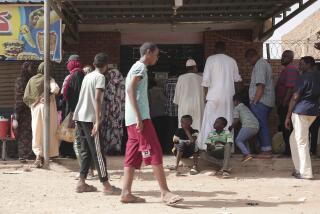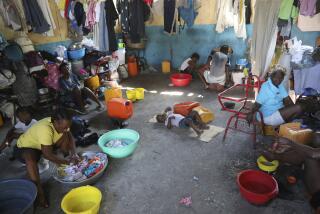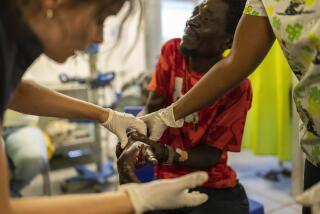Aid workers scramble to contain Haiti cholera outbreak
Doctors and aid workers scrambled Friday to rein in a cholera outbreak in central Haiti that has killed 140 people, while warning that the crisis probably would get worse in a country where tent camps are still teeming with people displaced by the January earthquake.
“There’s no reason to anticipate that this wouldn’t spread widely,” said Joia Mukherjee, chief medical officer for Partners In Health, a Boston-based relief organization that runs three hospitals in the area.
The acute bacterial illness, spread primarily through contaminated drinking water, has struck more than 2,000 people throughout the farming valley along the Artibonite River, with the highest number in the port city of St. Marc.
Officials feared the disease could reach the capital, Port-au-Prince, 55 miles to the south, where hundreds of thousands of people are living in fetid conditions in the camps.
This is the first outbreak of cholera in Haiti in more than a century. It is unclear whether the massive displacement of people to the Artibonite Valley after the earthquake may have created the unsanitary conditions that allow such a disease to spread. But Haiti’s public water system has long been one of the worst in the world, and health officials have perennially warned of an epidemic.
The World Health Organization says less than half the country uses “improved drinking water sources,” and a 2008 Partners In Health report found that 70% of Haitians lacked continuous direct access to clean water.
Cholera causes such severe diarrhea and vomiting that people can die of dehydration in little more than a few hours. It spreads rapidly when infected fecal matter enters the water supply.
Speaking via a teleconference, Mukherjee said officials have confirmed that the water of the Artibonite River was one source for the contamination, but expected there to be others.
“The wells in St. Marc are too shallow and contaminated with sea water as well as surface waste water,” she said.
Despite fears that the disease could reach the densely populated capital, Mukherjee said it was harder to end an epidemic in rural areas, where people are scattered and get their water from myriad sources. Most of the displaced people in tent camps in Port-au-Prince have access to clean water provided by relief organizations, said Julie Schindall, spokeswoman for Oxfam, which she said provides an estimated 315,000 people with clean water.
The cluster of international groups responsible for water and sanitation in the wake of the earthquake met in St. Marc on Friday to coordinate a response.
“It’s going to take a serious mobilization,” Schindall said. “Luckily, we have a lot of stock in the country.”
Jon Andrus, deputy director of the Pan American Health Organization, said the disease was relatively simple to treat, with drinkable salt solutions that help rehydrate patients and reduce the risk of severe diarrhea. The best way to prevent infection is to keep food and water clean and wash hands often.
He said Haitians may be more vulnerable to widespread infection because they lack resistance to the disease. It was unclear how the bacterium was introduced after so long an absence.
Andrus said the first “suggestion” of the disease emerged Sunday, with reports of an abnormally high number of diarrhea cases in the area. It was later determined to be cholera.
He said his group was sending epidemiologists from Port-au-Prince and outside Haiti to deal with the outbreak.
Cholera kills between 100,000 and 120,000 people worldwide every year, often in regional epidemics. This month, an outbreak in central Africa has killed 1,879 people. The disease was absent from the Western Hemisphere until 1991 when it killed nearly 3,000 people in Peru and spread throughout Latin America.
Times staff writer Ken Ellingwood in Mexico City contributed to this report.
More to Read
Sign up for Essential California
The most important California stories and recommendations in your inbox every morning.
You may occasionally receive promotional content from the Los Angeles Times.











